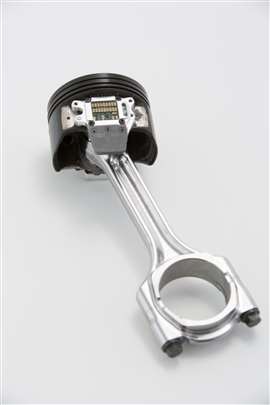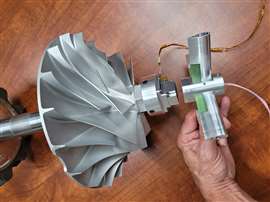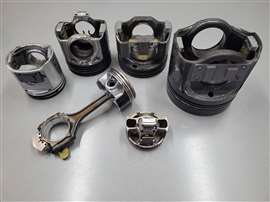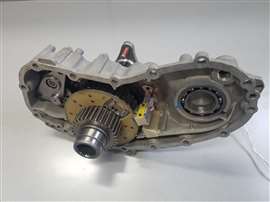IR Telemetrics can make powertrain components speak
01 August 2023
Company specializes in the real-time transfer of data from moving components
For more than 30 years, IR Telemetrics has helped product development teams around the world collect data from internal reciprocating and rotating components in harsh environments. In so doing it has helped companies develop reliable jet engines, diesel engines, construction equipment, transmissions and more. These days, founder Glen Barna said the company is busier than ever thanks to work surrounding the use of alternative fuels such as natural gas, hydrogen, ethanol and ammonia.
“Everything changes when you change the fuel in engine, and there’s a lot of that going on right now,” said Barna. “You’ll see different compression temperatures and different cylinder pressures, but our thermocouples don’t care whether they’re measuring heat produced by diesel fuel, gasoline, hydrogen or ammonia. All these new fuels -- especially the green fuels -- are creating a lot more work for us, which is wonderful. That’s what we want.”
 Microwave telemetry components installed on a piston. (Photo: IR Telemetrics)
Microwave telemetry components installed on a piston. (Photo: IR Telemetrics)
Michigan Tech grad
The company’s foundation was an infrared (that’s the “IR” in the company’s name) wireless telemetry system that Barna developed while a graduate student at Michigan Technological University. The work quickly caught the attention of engineers at Ford Motor Co. and General Motors, so Barna and his advisor, Michigan Tech professor Carl Anderson (now retired), launched the company to support the work. The duo operated out of the university for a few years before the operation moved to its current location in Hancock, Mich. – a building that has been expanded multiple times in terms of footprint and number of employees.
“We probably could have grown faster, but I chose a path that was more conservative because I didn’t want to look for venture capitalists,” said Barna.
The strategy has paid off: “We’ve got a pretty extensive customer list today.”
Today, IR Telemetrics specializes in the real-time transfer of data from moving components as they go through their typical work cycle. The company uses technology that has continuously evolved in-house to help customers extract important measurements despite the harsh operating conditions of engines, turbines and other systems and components. Its infrared, microwave and high-speed multi-channel digital telemetry systems provide engineers operating parameter measurements via single or multiple channels – offering data collection that the company said was previously thought impossible.
“A lot of our work is used to validate computer models,” said Barna. “Nearly every project we do is custom, even though it may be similar to another project. There are always differences that require a new design or a new technique. That’s the brunt of our work: custom design and custom installation.”
Rarely saying “No”
“Over the last 30 years, we haven’t said ‘we can’t do that’ to many people,” said Paul LaVigne, vice president of IR Telemetrics. A mechanical engineer with a degree from Michigan Tech, he ran an engineering consulting firm that originally took on Barna’s company as a customer. He joined IR Telemetrics full-time in 1996.
“A lot of our technology has evolved out of a customer need,” said LaVigne. “For example, there was a project with an OEM where they wanted to measure impact loads on a gear on the front of the engine to validate a 3D model. The engineers wanted 32 channels at 50 kilohertz per channel, simultaneously. We didn’t have that technology when they called but we developed it to meet that need.
“Another customer wanted to measure ring motion on a piston and there wasn’t an off-the-shelf transducer that would do that. So, we developed our own We also developed a transducer to measure pin rotation on a piston with technology that didn’t previously exist.”
In another example, IR Telemetrics’ engineers developed a way for a customer to measure lubricating oil flow along a connecting rod.
“Over the years, a lot of our capabilities that didn’t originally exist have evolved out of customer needs, where we’ll figure out a way to measure what they need,” said LaVigne.
 IR Telemetrics prepares a turbine from a turbocharger for testing. (Photo: IR Telemetrics photo)
IR Telemetrics prepares a turbine from a turbocharger for testing. (Photo: IR Telemetrics photo)
Reliable data
With reciprocating, rotating and track systems, wireless measurement has been found to be the most reliable way to get data from moving parts.
IR Telemetrics said it has instrumented every component from the piston to the wheel hub, including pistons, wrist pins, connecting rods, crankshafts, camshafts, clutches, torque converters, transmissions and differentials. Because of the severe loads experienced by diesel engines, wireless transmitters require careful packaging and installation, which the company said its engineers routinely perform.
“We’ve done a wide variety of project types over the years,” said Barna. “We’ve put thermocouples on big diesel turbochargers spinning at 40,000 rpm to get data from them. We’re currently developing a 128 channel, 24 bit, 400,000 sample per second wireless transmitter designed for turbo machinery like jet engines and things of that nature. For a wireless instrument, we think it will be the leader of the industry.”
“We have measured most everything on pistons. Surface temperature, embedded temperature, ring land pressure, vertical ring motion, strain, pin motion and pin rotation. We often do multiple types of measurements on one component,” said LaVigne. “We’ve instrumented pistons where we’re measuring temperatures, ring land pressures and ring motion with multiple transmitters installed on one piston. We have also measured piston temperature, pin temperature and pin rotation all at the same time on the same piston. Providing multiple measurements on a single piston is a powerful tool, because it gives the engineers real time data on all the interacting components. And we’ve also worked on some very complicated eight-speed automotive automatic transmissions, where we’ve had multiple transmitters inside measuring reaction plate temperatures and oil pressures on multiple clutches, as well as multiple temperature and pressure measurements inside torque converters.”
By accessing data from multiple measurements at the same time, customers can more quickly correlate what’s taking place inside the engine block or transmission case.
 The company’s technology has helped engineers extract data from a wide range of components. (Photo: IR Telemetrics)
The company’s technology has helped engineers extract data from a wide range of components. (Photo: IR Telemetrics)
Virtual meetings and onsite visits
When IR Telemetrics’ phone rings, the caller is typically from one of three groups: product development, research and development or failure analysis.
Prior to 2020, the collaboration once got under way with a trip to the customer’s location, but the pandemic perfected the virtual meeting. “The Zoom meeting has really evolved and become more efficient during the early stages of a project,” said LaVigne, “because they can have all their engineers and we can have all of our engineers in the same meeting when we take a look at a project. We can get a lot more questions answered right at the start. We also use those Zoom meetings to keep customers updated on the progress as we move through the process.”
Sometimes during the virtual meeting stage, the company’s engineering team can suggest an alternative based on its years of experience in a broad range of projects.
“We’re not going to fleece anybody just to get a project out of it,” said Barna. “We will be helpful in their measurement needs, even if it means we don’t necessarily get a project out of it.”
While much of the work is performed in Hancock, when IR Telemetrics does go onsite it’s to support the customer’s test plan or to do on-site installations.
“The typical project is two to three months, and we will do all the work on the parts. If a customer wants the temperature from a piston in a running engine, we’ll get the piston here, do all the instrumentation and get all transducers and electronics on board. Sometimes on a small engine we’ll get the engine up here in the shop and put on whatever is necessary for the test to run. When we send the part back, it’s ready for them start the test and take data.”
When the customer starts to collect data points, the IR Telemetrics team will collect files to ensure everything’s working properly before the customer runs hours of testing.
“We’ve always been very, very strong with onsite support,” said LaVigne. “If the customer is in the middle of a test and they’re having issues that can’t be resolved over the phone, we’ll make a trip down there to help.
“When a customer purchases a telemetry system installed on a component, what they’re really purchasing is the data that it provides. We’ve always given a 100% guarantee that our telemetry system is going to work and provide the customer with the data that they’re after in the initial testing phase.”
According to Barna, the company can provide signal analysis support for its customers, but that isn’t always required.
“We don’t pretend to be engine experts, but we’ve seen enough data on enough different parts over the years that we can really be a value added for our customer when we look at this information,” he said.
 Tasked with measuring temperature in this transfer case, technology employed by IR Telemetrics included a microwave transmitter. (Photo: IR Telemetrics)
Tasked with measuring temperature in this transfer case, technology employed by IR Telemetrics included a microwave transmitter. (Photo: IR Telemetrics)
Wireless systems used by IR Telemetrics
Analog Microwave Telemetry
- Analog (10 kHz bandwidth)
- Toughest environments
- Smallest packaging
- Inductively powered or battery-powered
- 185 deg C capability
- Multiple channel capability (sequentially multiplexed)
- High G-loading capability (6000 g’s reciprocating/50,000 g’s rotating)
- Accuracy +/- 1 %
High Speed Digital Telemetry
- Analog (10 kHz bandwidth)
- Toughest environments
- Smallest packaging
- Inductively powered or battery powered
- 185 deg C capability
- Multiple channel capability (sequentially multiplexed)
- High G-loading capability (6000 g’s reciprocating / 50,000 g’s rotating)
- Accuracy +/- 1 %
This article was originally published in the June 2023 issue of Diesel Progress
STAY CONNECTED




Receive the information you need when you need it through our world-leading magazines, newsletters and daily briefings.
POWER SOURCING GUIDE
The trusted reference and buyer’s guide for 83 years
The original “desktop search engine,” guiding nearly 10,000 users in more than 90 countries it is the primary reference for specifications and details on all the components that go into engine systems.
Visit Now
CONNECT WITH THE TEAM










